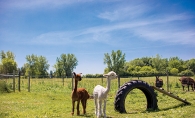Spring is finally here! There’s nothing quite like seeing those first furls of green making their way up through the soil and bursting into leaves. I’m continually astonished by the jump start my perennials offer for eating from garden as early as possible—with as little work as possible.
A perennial is any plant that comes back year after year, including trees and shrubs.
Here, we’ll focus on herbaceous perennials, plants that die back to the ground every winter. Some of my favorite perennials for Northern food gardens:
Asparagus: Planted as bare roots, these are a great addition to any food garden. They will take 2-3 years to establish as plants before you can start harvesting, but the wait is worth it. They will continue to crop for more than a dozen years.
Chives: Being able to add the fresh zing of chives to eggs in early May is one of the joys home gardeners look forward to. Chives are a very easy plant to grow and keep alive year after year. They have almost no pests or diseases. One plant (or pack of seeds if started by early April here in zone 4b) will last for years, eventually growing large enough to split.
Rhubarb: This is one of the first plants to emerge each spring and is technically a vegetable though we prepare it as a fruit. The plants will produce well for at least a decade, and side shoots can be transplanted to keep growing. Make sure to only eat the stems, as the leaves are poisonous.
For the adventurous souls, there are some spring edibles worth foraging for: stinging nettle, ramps, fiddleheads, cattails, lamb’s quarters.
Full articles on growing asparagus and spring foraging can be found on my website, forksinthedirt.com. You can also sign up for my virtual classes happening now.
Dig In!
Michelle Bruhn is a writer, educator and community organizer focused on helping neighbors dig local food through her Forks in the Dirt online presence, classes and farmers markets.









